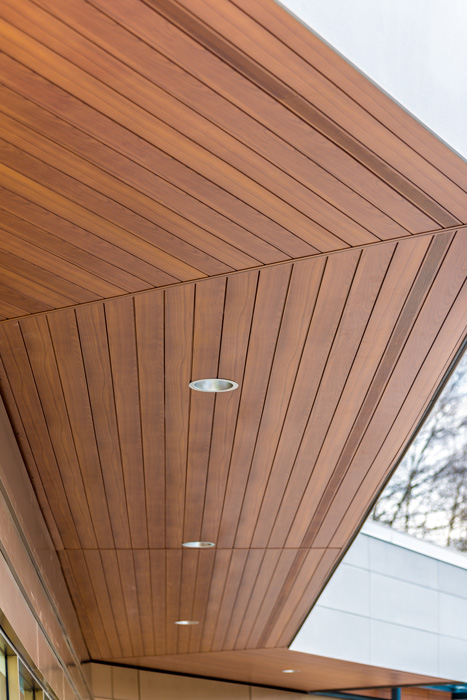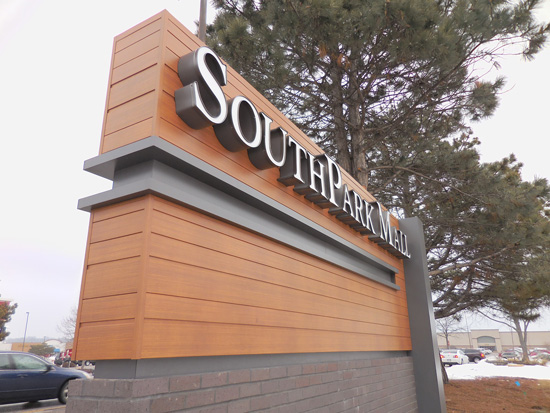Easing Minds and Boosting Facade Performance
SHOPPING FOR COMFORT
With increased interest in not only physical comforts but also psychological comforts for building occupants, many architects are assisting their clients in “humanizing” their architectural projects in a variety of ways, a notion widely ascribed in the modern era to a 1940 essay by Alvar Aalto, “The Humanizing of Architecture.”5

Photo courtesy of Longboard – A division of Mayne Coatings Corp.
In a unique application, B+H Architects specified a woodgrained system of aluminum tubes to create a privacy screen for Pemberton Plaza, a shopping center in North Vancouver, British Columbia.

Photo courtesy of Longboard – A division of Mayne Coatings Corp.
The wood-look aluminum soffit for Pemberton Plaza is rendered in a light cherry finish produced with a sublimation powder-coat process.

Photo courtesy of Longboard – A division of Mayne Coatings Corp.
The Towson Commons project in downtown Towson, Maryland, presents a friendly and naturalistic facade designed by BCT Architects with a system of woodgrain aluminum tubes in a dark cherry pattern.
Today, this idea pervades designs for cities, campuses, and large-scale environments. As the 2015 AIA Gold Medal honoree Moshe Safdie, FAIA, said in his acceptance speech in Atlanta, “Humanizing megascale is the single most urgent task that awaits us in the decades to come.” He added, “I have a dream of high-rise cities transformed, penetrated by light and sun, with plant life and gardens on land and sky.” The use of sunlight and biophilic elements are among the tools to humanize places, alongside recognizable and often “residential” elements in unexpected ways. A growing cadre of architects, notably including New York City-based John Cetra, AIA, have focused these efforts on “the notion of home,” instilling residential comforts, reassurances, and amenities in varied projects ranging from schools and houses of worship to hospitality settings and office buildings.

Photo courtesy of Longboard – A division of Mayne Coatings Corp.
For a shopping mall in Moline, Illinois, the architect FRCH conceived a major renovation, adding new access points and signage, better lighting, parking lot resurfacing, and more ample landscaping. The signage, in woodgrain aluminum, echoes the facade materials.
These humanizing trends can be seen in a recent project by owners of large shopping malls. Many malls are struggling to attract crowds in the face of increased online commerce and consumer unease with some public retail settings, where relatively isolated reports of harassment, vandalism, and Black Friday crowd violence have garnered visibility through social media and traditional news coverage. The Santa Monica, California-based owner-developer Macerich Company, for example, has been touting its redevelopment of retail properties with more “comfortable and convenient” amenities, including “seating vignettes” with more outlets for recharging handheld devices. The campaign has increased visitor turnout at several locations, including another property in Tysons Corner, Va., where the developer recently undertook a “large-scale vertical densification” project, adding new floors to that Virginia mixed-use complex.
In a related twist, Macerich is also downsizing some properties. At a 40-year-old center, the SouthPark Mall in Moline, Illinois, the company has demolished about one-quarter of its million-square-foot building, eliminating a food court and Sears store that were built in 1990. The plans included a new access point and entry to the mall, which would alleviate congestion at its current access. Other people-friendly upgrades included new signage, better lighting, parking lot resurfacing, and more ample landscaping.
Tapped to enhance the public image and functionality of a more human-scaled, shopper-friendly mall experience, the firm FRCH Worldwide proposed a facade renovation with an unexpected yet welcoming touch of woodgrain—something more associated with big-box outdoor retailers and lodge-style malls in the Rockies. “Our design concept was to articulate the facade with wood treatment” to add visual warmth, says Jennifer Eng, a senior designer with the Cincinnati-based architecture, interiors, and branding firm. With this in mind, the project architects compared woodgrained aluminum siding with two ventilated facade systems: one clad in porcelain tile and the other with composite panels.
According to Eng, the firm compared the three products side-by-side for durability, product strength, availability, lead time, pricing, and compatibility with the existing conditions. The firm had prior experience with aluminum siding on projects with similar aesthetic and budgetary requirements. “The strength of the aluminum siding was appealing in a retail environment where vandalism may occur,” says Eng. “With the siding, there was very little chance for denting or warping.” The manufacturer also offered repair and maintenance methods that worked well for the facility managers. Other benefits were critical to the timely completion of the redevelopment. “The siding product had easier installation, less weight loading added to the existing structure, and proven examples in several multi-weather areas,” says Eng. “Overall, the client’s feedback was positive regarding the warm wood appearance of the product.”
According to Lew Steinbrecher, Moline’s city administrator, SouthPark Mall’s four anchor tenants “are committed to stay and excited about what’s happening,” noting the numerous stores that had remodeled or developed “new store prototypes.” Traffic to the mall is up, and anecdotal evidence suggests this major refresh is highly appealing to Moline-area consumers.

Photo courtesy of Longboard – A division of Mayne Coatings Corp.
The look of wood offers a friendly face for educational facilities and has proven, subtle effects related to biophilia, helping calm students and restore their energy and well-being. Examples include the Ecole des Aventuriers in Sherbrooke, Quebec, designed by the firm Espace Vital Architecture.









